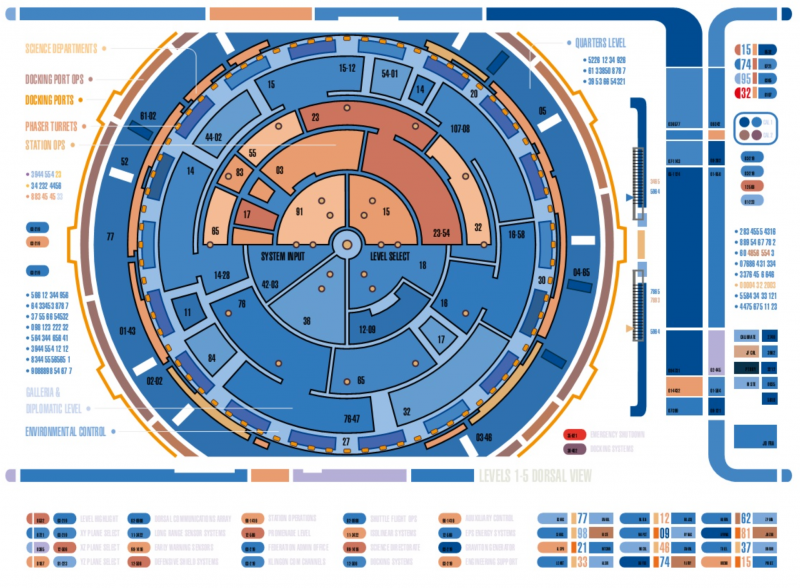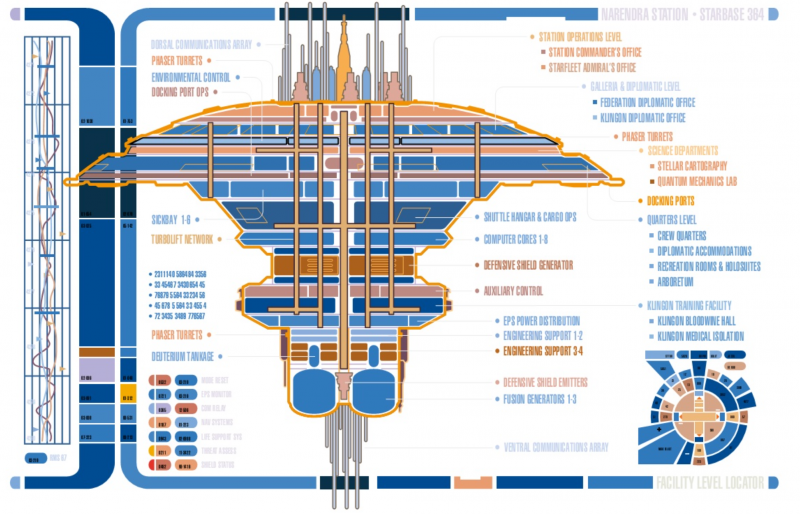Narendra Station
Starbase 364, known colloquially as Narendra Station, is the joint Federation/Klingon outpost used as a way point into the Shackleton Expanse.
History
Construction of the deep-space station formally designated as Starbase 364, informally known as Narendra Station, began in the early 2350s; the station was deemed fully operational in 2369. Built in tribute to the Klingon colonists who were massacred during a Romulan sneak attack against the Narendra III outpost in 2344, the starbase also serves as a reminder of the pivotal shift in Klingon- Federation relations that assault caused. Starbase 364’s dedication ceremony was conducted on the 25th anniversary of the massacre and included the unveiling of a memorial for the fallen of both Federation and Empire.
Narendra Station was built to enhance the existing Federation-Empire partnership. Both Starfleet and Klingon personnel and their families live and work here, pursuing missions and goals relevant to their individual governments as well as joint tasks that serve to further support continuing collaborative efforts. Given the station’s location and relative isolation from more populated areas of Federation space, the station’s command staff has been granted broad authority to dispatch the vessels in its charge on missions of exploration as well as diplomacy.
To further illustrate the importance of the station and its location, Starfleet recently placed the 20th Fleet under the command of Admiral April Hebert and made the station her headquarters. The starbase stands ready to defend against threats to Federation and Klingon security, whether introduced by a known adversary such as the Romulans, or anyone or anything previously unidentified that might emerge from the unexplored depths of the Shackleton Expanse. Federation analysts believe that the deeper recesses of the Beta Quadrant may be one possible breeding ground for the Borg Collective, and should that adversary choose to pass through the Expanse to again attack the Federation and her allies, Starbase 364 may prove to be the first line of defense.
Staff
Rear Admiral April Hebert
General Kargan
Exterior Layout
The exterior of Starbase 364 resembles that of most Starfleet starbases, looking something like a giant mushroom in stationary orbit of Amir II, an uninhabited, resource-rich Class-M planet in the Amirii system. The dorsal and ventral sections of the station contain communications arrays or “antenna farms,” both Federation and Klingon in design. All comm traffic in this region of space passes through these arrays before being forwarded on to subspace relay satellites and then toward their final destinations. Dedicated shield generators protect both antenna arrays from focused attacks.
Being on the far frontier of both the Federation and Klingon Empire, the station carries a wide array of defensive screens and weaponry. The surface of the station is dotted with phaser turrets and phaser strips, as well as numerous torpedo launchers.
Interior Layout
While the exterior of Starbase 364 is almost entirely Federation in look and feel, every level of the interior of the station boasts a mix of Federation and Klingon design aesthetics. Every level of the station, to one degree or another, reflects and reinforces the alliance between the Federation and the Klingon Empire. The Galleria is the sole exception – it has undergone extensive upgrades and modifications since it was first built, with the many species plying their trades there adding their own distinctive cultural embellishments to the overall décor.
Starbase 364 consists of dozens of levels of varying dimensions. The following information details some of the most important levels and features found within the station, though this is by no means comprehensive.
Level 1: Operations
The topmost level of the station, referred to as Operations, or simply Ops, contains the station’s primary command center as well as separate office suites for Admiral Hebert and General Kargan, the co-administrators of the station and joint commanders of regional alliance operations. An expansive auditorium, large enough to host more than a hundred officers and guests at a single sitting, dominates a twenty-degree arc of the level.
Level 3: The Galleria
One of the largest sections of the station is Level 3, better known as the Galleria, which contains over four hundred business establishments owned and operated by a wide variety of species hailing from all across the Alpha and Beta Quadrants. Level 3 is a bit of a misnomer, given that the Galleria includes several terraced sublevels haphazardly arranged around the whole level. At one point Level 3 enjoyed a specific symmetrical design aesthetic, but once it began to be populated by vendors, the new locals discovered that the many modular bulkheads and terraces could be rearranged as needed, and soon turned the Galleria into an architectural marvel unique to this station. Restaurants, kiosks, salons, parlors, and shops and stores of all kinds may be found within the Galleria, offering a bewildering array of food, clothing, personal care services, and other offerings not generally found on dedicated Federation starbases or outposts. Of particular interest are the many “fusion” delicacies to be found in the station’s many fresh food cafeterias, brought about by dozens of culinary artists living and working in close proximity, trading insights, spices, and recipes that may have never been intended to be mixed. It’s highly unlikely you’ll find Idanian spiced gladst or Gunji jackdaw wings smothered in li hing infused plomeek glaze anywhere else in the Galaxy.
Virtually anything can be found in the Galleria for the right price or the right trade, with a few notable exceptions. Slavery or indentured servitude of any kind are prohibited under Federation law and have no place on the station. The trade or sale of most forms of controlled substances, illegal pharmaceuticals, and military-grade weapons are likewise banned, though rumors of a healthy black market on the station persist despite the best efforts of the station’s two security chiefs, Lt. Commander Sar Doveli and Lieutenant Kahbel, and their security teams.
Level 5: Sciences
The domain of the station’s chief scientist, Doctor Helena Taliaferro, Level 5 contains the station’s extensive research laboratories, including a massive stellar cartography installation and a newly installed experimental quantum mechanics lab. This level also contains a communications center for scientific use, backup computer cores, lecture halls, and secure storage facilities for fragile experiments or precious artifacts.
Level 6: Personnel Quarters
Similar to the Galleria, the level containing the bulk of the station’s personnel quarters is multi-tiered and terraced. This level holds hundreds of single-, double-, and family sized occupancy quarters, as well as diplomatic suites, recreation centers, game rooms, rows of holosuites, and a selection of restaurants and food kiosks, some of which are franchises of those found on the Galleria level. Occupying a wide section in the center of the level is the station’s arboretum, some 40 meters in height and full of tall trees and colorful plants culled from all across inhabited space.
Level 7: Medical
Level 7, usually referred to as “Medical,” contains the major medical facilities for the station and for the 20th Fleet. The level contains six separate sickbays, each the equivalent of what would be found on any large starship. The level includes counseling centers, pediatric wards capable of supporting a wide variety of species, an isolated pandemic ward, extensive research laboratories, cryogenic stasis racks, triage centers, a pair of training holosuites, and dedicated transporter pads for rapid casualty delivery. Each sickbay specializes in a specific field of medicine and has its own Mark I Emergency Medical Hologram, with its programming adjusted for that specific field of medicine. This has resulted in each of the six EMHs possessing distinctive mannerisms and bedside manners beyond the program’s baseline.
Cargo Operations and the Hangar Deck
As the hub of operations in the Shackleton Expanse region of space, Starbase 364 manages a dizzying array of cargo moving to and from the station on a daily, if not hourly, basis. The complex logistic requirements of managing such extensive and ongoing cargo transit requires a massive cargo bay, which the station amply provides.
The midline of the station is a cavernous space split into six main bays, or “wedges,” with reinforced support bulkheads dotted with pressure hatches and forcefield backups that enable any of the six wedges to be isolated from the others as needed. The internal configuration of stationary hatches and pass-throughs could allow a small craft to enter one wedge and exit out the opposite side of the station, though this is rarely encouraged in practice given the extensive traffic in and out of the station. The available internal volume of the wedges contains significant space for cargo pallets and shipping containers, short-term and long-term repair bays, propellant stores, warp coil stacks, impulse engine spares, and secured armaments facilities for any armed small craft.
Starfleet’s Master Chief Petty Officer Tiene manages the flight deck and overall cargo operations. Each wedge is commanded by a senior chief petty officer or Klingon equivalent rank. In effect, each wedge is its own cargo center and hangar and operates independently at its own operational tempo, though the seven chiefs regularly coordinate their efforts to ensure optimal efficiency. Given that the seven chiefs comprise a mix of Federation and Klingon officers, negotiations and performance often look messy and chaotic to an outsider. The truth is that under Master Chief Tiene’s leadership, the station’s cargo operations and flight decks are usually models of interspecies cooperation and operational effectiveness.
Support Craft
All six wedges comprising the main hangar host racks of Federation and Klingon manned and automated cargo pods, worker bees, and EV suits. The many small craft assigned to the station are also berthed at various points within the six wedges, and can be moved from sublevel to sublevel via lifts or from wedge to wedge via antigrav conveyors. Narendra Station houses dozens of shuttlepods and shuttlecraft of various types and designs. In addition, the station is home to four Danube-class runabouts and two Qo’Toch-class heavy fighters, all of which are available to support 20th Fleet operations inside and outside the Expanse. Two of the six vessels are on “hot standby” at any given time, and each has a dedicated flight boss responsible for its maintenance schedule.
Engineering Complex
Like the Galleria, calling the engineering complex a single level would be something of a misnomer, given that the complex is an extensive collection of facilities located below the midpoint of the station, just above the three massive fusion generators mounted at the “bottom” of the station. Engineering comprises four large support levels, connected via turbolifts, Jefferies tubes, personal antigrav tubes, and humble ladders.
The engineering complex contains kilometers of ODN network cabling, EPS power distribution nodes, GNDN power relays, several deuterium tanks, and more, all connected to the station’s fusion generators. The station’s main computer cores are several levels “up,” though engineering houses most of the backup cores, as well as the hardened auxiliary control center.
Klingon Training Facility
One of the lowermost levels of the station is a multi-tiered Klingon facility rarely visited by non-Klingons. The facility boasts a massive bloodwine hall, targ breeding pits, a dedicated Klingon-only medical ward, and an extensive, well-equipped combat training center. The overall décor within the facility is pure Klingon in design, and it is believed that many of the tapestries and decorative bulkhead fittings are on loan from the Great Hall on Qo’noS. The Klingon training facility is operated and maintained by the imposing Lady J'Darc.
Fusion Generators
The station’s primary power is produced by three massive fusion generators attached to the bottom of the engineering level. Each generator contains four linked fusion reaction chambers that collectively distribute energized plasma throughout the station. Two generators operating at full capacity are sufficient to meet most of the station’s power requirements; because of this, they are regularly rotated in and out of service for maintenance and hardware conservation. Each of the three generators can be ejected from the station core in the event of a catastrophe.

